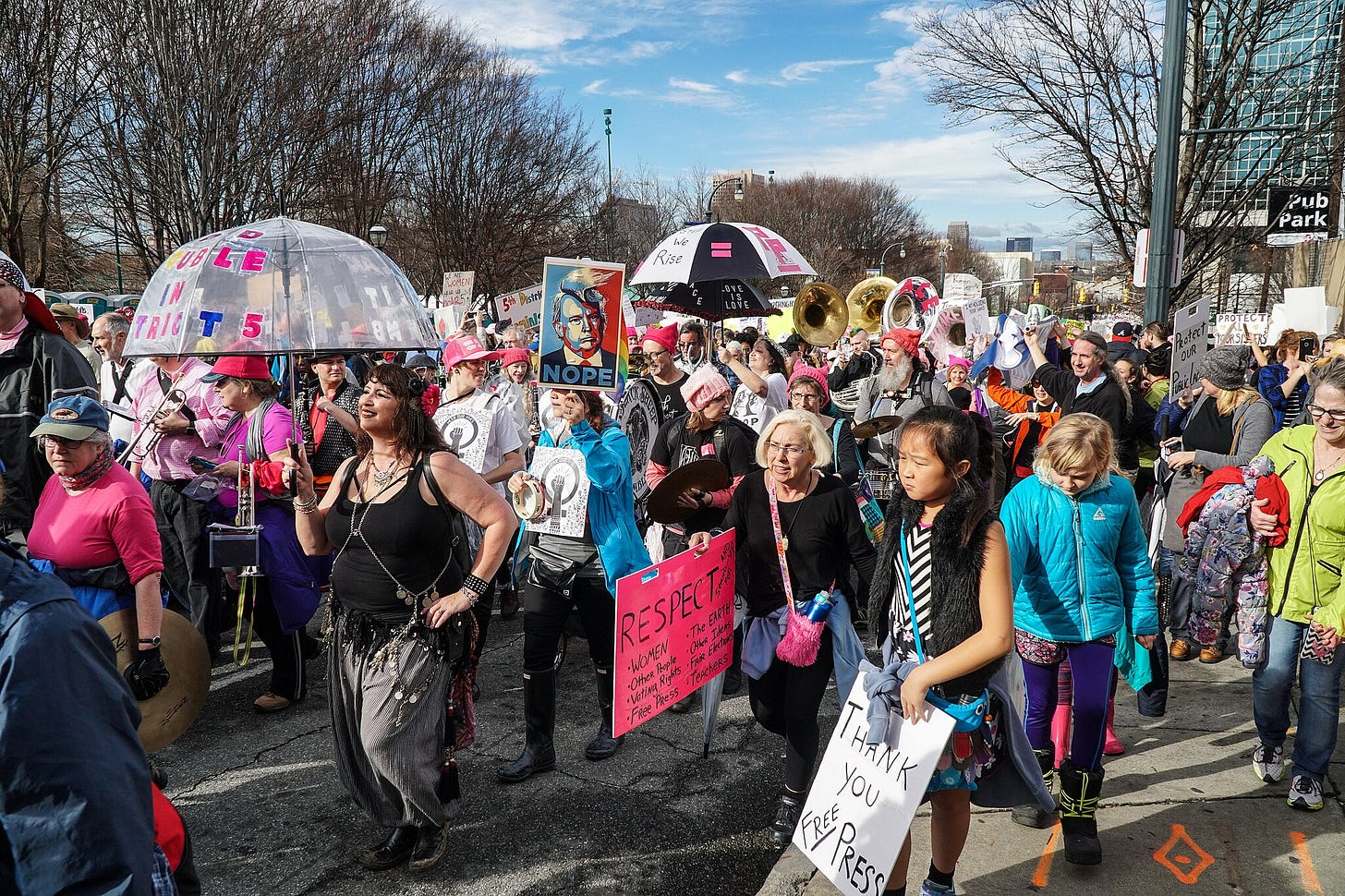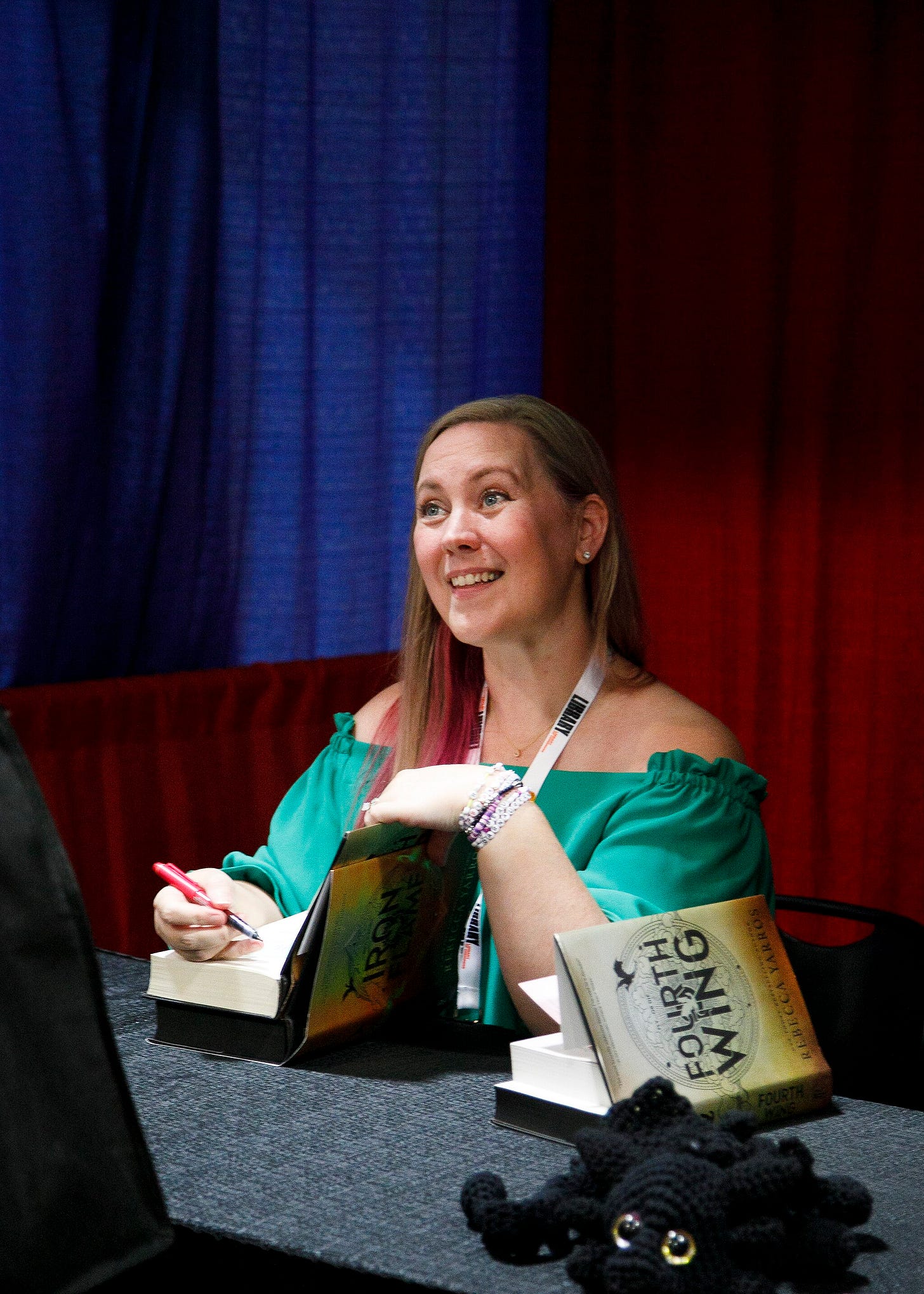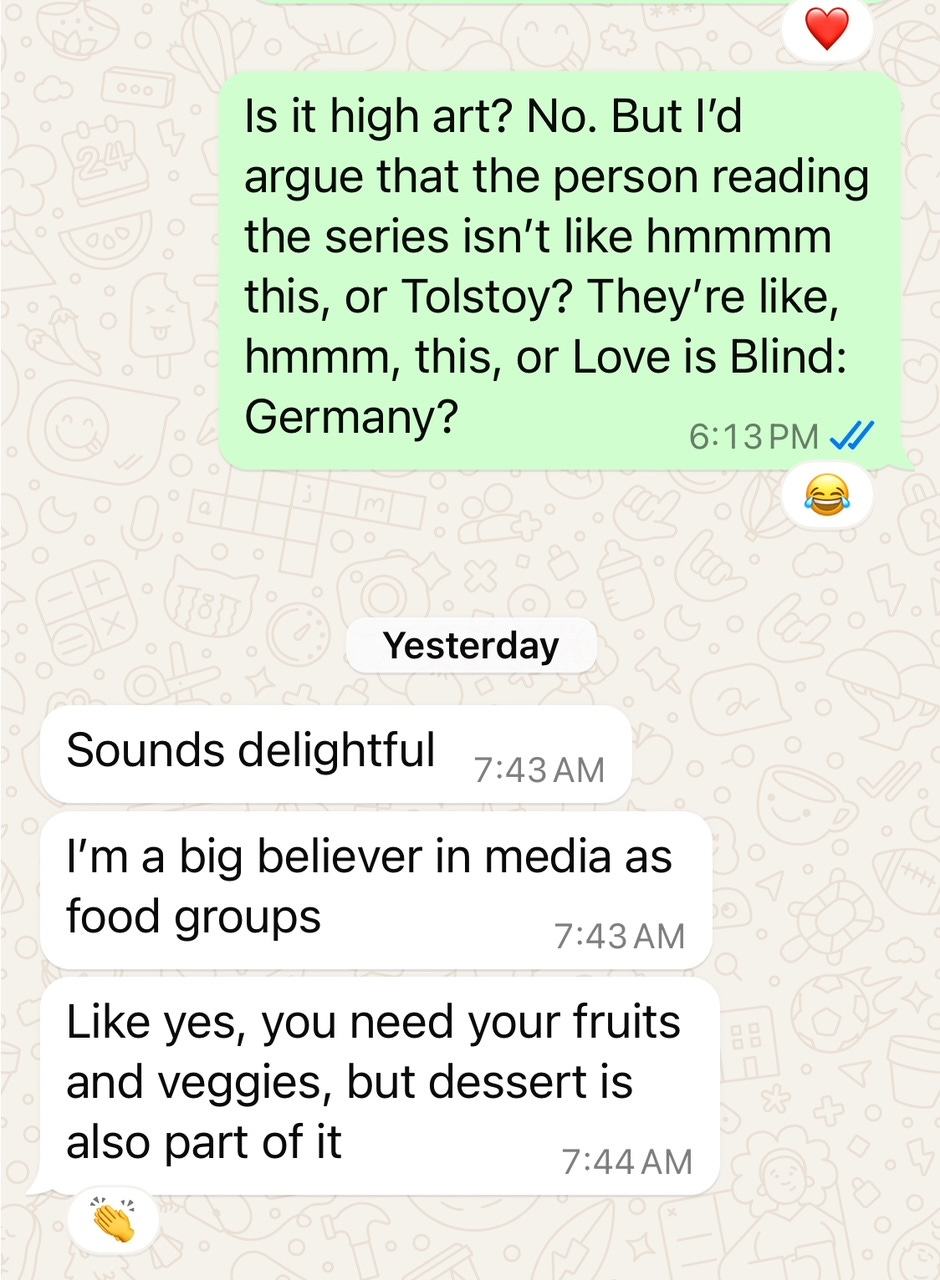Love and liberation in the land of Rebecca Yarros
If I can't binge-read sexy feminist fantasy, then it's not my revolution
“Joy has to become a discipline and a practice, even when we feel like it is not something that feels like it is in solidarity with the moment—the heaviness, the density, the realism of the moment. We have to choose joy, because joy, for me, becomes a way that I restore myself for the work. You can get too tight and serious about liberation, and it ends up spinning you further into incarceration.” — Lama Rod Owens
Recently I found myself with a lot of time on my hands in the hospital, and a stack of books by Rebecca Yarros to read, delivered by some folks who knew I needed a distraction. And wow, did they deliver, as anyone familiar with her smash-hit Empyrean series already knows. I read all three brick-size hardcovers in a week.
What interested me most was not just the content of the books, which follow the adventures of twenty-something Violet Sorrengail as she navigates life and love, in a world full of government corruption and smoldering revolutionaries. (More on this later.)
What intrigued me was the excitement with which my stack of books was met by over half of the nursing staff.
At least six women stopped what they were doing — and it was a busy time in the hospital, with the ER at full capacity — to talk to me at length about the series, and in particular the third hyped title, Onyx Storm, which just dropped. One nurse gave me the latest goss from TikTok about the fan reaction to the series. Another said that the buzz reminded her of the late ‘90s hype around the Harry Potter series. A colleague of theirs overheard us and said wonderingly, “How do you all have time to read? I barely have the energy to cook and sleep.”
“Just read these books,” one of them told her, adjusting her cool-girl clear glasses. “Then you’ll understand.”
As a former romantasy skeptic, I could stop here and tell you to do the same. (I would also tell you to stop here if you don’t want to read any spoilers, and come back when you’ve finished the series.)
I think there’s more to say here, though, about what these books can teach us.

Right now we need art that helps us fight oppression. We need art that reminds us of why life is worth living. And we need of community organizing efforts that offer us the same.
The sense of community and cohesion around these books proves my point. People will come together around meaning and joy and belonging, even when they supposedly don’t have time, far more often than they will come together when they are being whipped into a state of fear or shame. Including by people who would otherwise be their natural allies.
This is a sentiment other longtime meditators and activists have shared recently as well.
As Lama Rod Owens said after the election, building on his comments quoted above:
“Some of you really struggle to build communities, to build movements, because you're too intense. I think it's time to say that. You don't invite people into the work. You push people away. People are like, ‘I can't live up to this intensity. You have a standard of liberation that's unattainable. And if that's your liberation, I don't want it.’ One of my favorite quotes is by Emma Goldman: ‘If I can't dance, it's not my revolution.’ If I can't drop it like it’s hot, then don’t invite me.”
Caregivers are already weighed down by unattainable standards in so many ways. Our lives are already characterized by inescapable intensity. So if the art I consume in my downtime doesn’t revive and inspire and even delight me — if it doesn’t restore me for the work — then don’t invite me.
Rebecca Yarros, a Millennial mom with six kids and a chronic illness, clearly knows from crushing responsibility, and has understood her assignment. So let’s talk about what she’s actually done here, and why it might help us to create better stories and movements to meet this particularly dour historical moment.
As a thought experiment to prepare you for what I’m about to say, imagine the following: Star Wars begins not with Luke but with Leia. She’s tasked with living up to the standards set by others in her lineage. She has to overcome sexism, learn to use a weapon, and ultimately figure out how to win a revolution against a foe that is far more heavily armed and organized. In the meantime, she has to choose between the guy that seems like a safe bet and the rougue-ish loner who stumbles onto her path and seems intent on making it more treacherous. Is this a story you’d like to see on the screen?
Now imagine you’re reading Hermione and the Sorcerer’s Stone. The author is not a deeply problematic crank; the muse has in fact skipped her and dropped her blockbuster-series ambitions on a different author, one who actually seems to like queer and nonbinary people. Rather than treating us to fatphobic diatribes featuring the Dursleys, we see more scenes of Hermione dealing with dudes in her school who seem hellbent on second-guessing her choices every minute of her day. That is, until she eclipses them all in smarts and talent, and finds better allies (and romantic partners) who love and value her. Would a story like that get you off the couch and into your nearest bookstore?
If you felt some small thrill as you considered the above, then you now have some sense of what the Empyrean series offers to readers. Which is to say, the same fantasy and sci-fi tropes we know and love, but with a female gaze and voice. It’s almost like publishers and moviemakers could have been giving us this all along.
“Romance is this beautiful place where women get to say on the page what we want, what we deserve, what healthy relationships should look like.” — Rebecca Yarros
In The Fourth Wing, we meet Violet Sorrengail, a Leia-Hermione hybrid who is born into a military family. Though she aspires to be a scribe — a kind of librarian-cum-journalist who narrates and organizes the history of Navarre, their nation — her general mother forces her to train as a dragon-rider instead.
This is inconvenient, because Violet has a condition that makes her physically fragile. Given this, her childhood bestie spends half the book trying to “save” her from a life of warriorship by smuggling her out of dragon-rider school. Eventually, though, she realizes she’s capable of simply outsmarting the jocks in her classes that she can’t overpower. So smart, in fact, that Violet uncovers some big government secrets that are leading to the deaths of many innocent people, and has to team up with the leaders of an underground revolution — also dragon riders — to make things right. Luckily for her, one of them is very attractive and thinks she’s a badass, even if she does have bad knees. (Truly a tired millennial mother’s dream!)
I haven’t read A Court of Thorns and Roses, aka ACOTAR, the series by Sarah J. Maas to which this one is most often compared, but thanks to , I’m familiar with common reader likes/dislikes vis a vis that series, and the romantasy genre in general. People say that it’s mainly a vehicle for hotness, with scenes that only loosely connect in order to drive forward a sexy and explicit storyline between monogamous straights.1 While I don’t judge folks for enjoying that, this wasn’t my experience of Yarros’ series (and ACOTAR fans may not find those critiques fair, either). There’s a fairly elaborate plot and cast of well-rounded characters in Yarros’ books. Women in this series hold leadership positions, express and fulfill desires, and regularly pass the Bechdel test.2 They do so while being Deaf and chronically ill, queer and ethically non-monogamous, ambivalent about their mothers and protective of their chosen family.
At the same time, the overall effect is not distractingly politically correct. People casually swear, insult, and kill each other on the regular in Yarros’ books, in ways that make it clear that ableism and toxic masculinity are alive and well in the militaristic society of Navarre. While talk of diets and food is blissfully absent, many characters are fixated on physical fitness and allergic to displays of “weakness,” as you might expect warriors to be. What we see is not the absence but the frequent transcendence of these cultural forces. It is strong relationships, as much if not more so than individual grit or merit, that allow characters to rise above self-doubt and prejudice to dream their way to a better nation. For a series that seems to be set in a vague, pre-industrial past, it’s a good fit for the emerging themes of 2025.
“Like, why am I into reading about a world that’s trying to figure out how to, like, fund the arts, and rectify past misogyny, and work towards equality, and no one [is] hung up on weird sexual mores and the planet isn’t dying? Weird that that’s a pleasant place for my mind to hang out for several hours every day!” — Anne Helen Petersen on the appeal of romantasy
Does this series have literary, manicured sentences a la Hemingway, though? Will it make you feel sophisticated as you carry it around on the subway? Will it impress the trolls in the New York Times comment section? Heck, no.
The gilded covers and larger-than-life titles make it clear that you’re reading a capital-F fantasy book. (There’s always Kindle.) Some passages clearly needed one more editing pass; as written, a few are so confusingly composed that they require multiple re-readings. (One might argue that this is the price you pay for actually getting the next book in the series in a timely fashion — looking at you, George R.R. Martin.) The characters speak like they’re in “Mean Girls” even as they sit astride dragons in a European-ish setting, in rapid-fire dialogues laden with dirty jokes and sarcasm. So do the dragons themselves, when they deign to speak at all. (When you’re recovering from surgery, as I was recently, one might argue that this too is a feature, not a bug. I would imagine the same is true for any exhausted nurse or tired mom picking this up at the end of a shift.)
If you can handle all this, you’ll easily survive a semester at Basgiath War College. In fact, you’ll probably really enjoy your time there. And joy is restorative. Does it matter so much where you find it these days, if it’s not hurting anybody? Are we really willing to grind people into the ground, for the sake of keeping supposedly more “literary” speculative fiction authors like Orwell on their dusty pedestals? Would we prefer to have would-be readers read nothing at all? I think the author of 1984 himself would hate that, not to mention most of our nation’s teachers and librarians.
I guess what I’m asking is this: in 2025, are we pretentious literary types ready to finally get over ourselves and have a little fun, given everything else that’s at stake in the world?
If you can’t, then maybe you're too intense, and I think it's time to say that.
Here’s where this connects to the real world work of community-building and activism. Caregivers, as I’ve noted, are tired. We are time-poor. But we are not apathetic, nor are we without organizing talents.
If activists are to create new movements to respond to the oppressive actions that are sure to come in the next four years, and we want them to include caregivers, we need to design calls to action and communities that are life-giving. That are joyful. That bring us not just justice but glee.
We need to draw in the same nurses who are binging these books on their Kindles after work, and heading in their thousands to see Rebecca Yarros speak on their weekends as if she were T-Swift, because they feel that they belong in the psychic and physical spaces she inhabits, and the stories she is telling have the power to restore them for the work. We need them to feel that way when they show up to the next info session for [insert your favorite nonprofit here].
The most successful and long-lasting organizations for which I’ve worked, as a longtime activist, are already doing this. Glee is an essential part of their strategy. As a twenty-something myself, I found that hosting African wine tastings to benefit Many Hopes, which supports girls’ education in Kenya, was a much more effective way to attract booze-loving Millennials to the cause than yet another 5k fundraiser email. In my thirties, I’ve hosted karaoke nights for grievers via The Dinner Party and benefited from big communal dance classes hosted RTZ Hope that are designed to help the body release trauma. And no one plans a week-long fiesta in D.C. like my friends at the Southern Utah Wilderness Alliance, which has been fighting drilling leases for decades now, and mobilizing voters to come tell their Congressional reps to do the same. People come to Wilderness Week to defend their public lands in Alaska or Virginia or Utah, sure, but they also very openly come to get the digits of other Teva-wearing hotties who are doing the work.3
As my friend Lissa likes to say, por que no los dos?
Anyone who dismisses the Women’s March in 2017 along similar lines, as “just a party,” is missing the point. I was there. The point of the Women’s March was that it restored us for the work ahead, not that it completed it. The point is that public displays of activism can and should be an outpouring of our most life-giving impulses, not a panopticon populated by our judgiest and most anxious selves, or a recreation of the warlike displays of our oppressors. The point is dropping despair like it’s hot.
By this, I don’t mean to say that we should spend all of our time at one-off demonstrations that don’t lead to long-lasting change, or use them to avoid our feelings of grief and/or helplessness in this moment. Most activists I’ve encountered, who are doer-fixer types by temperament, would benefit from cultivating practices that allow them to simply sit with these feelings, whether through self-compassion meditation or reflective writing. Grief work is a part of activism, just as it is with great literature. If we’re so busy organizing that we don’t allow ourselves to process our emotions, we’re bound to act out of rage and thirst for revenge and unprocessed trauma, which is to say we are bound to re-create these things, and perhaps to burn ourselves or others out in the process. If we do that, we will never have the peace we seek.4
But grief is just that — a part of the work. And I have written enough words on grief to know that grieving alone does not make us whole.
We need joy.

This message permeates the best fantasy books, the ones that draw us in and stay with us. The guardian angels of A Wrinkle in Time are clear that they exist to fight the darkness, but they also show Meg O’Leary planets full of singing and light. Those images have brought me comfort since my first encounters with the series as a child, when I would lie awake listening to my parents fighting in the room next door. The characters in Ursula K. LeGuin’s The Left Hand of Darkness must traverse an endless, alien winter landscape together, but they survive because they love and trust each other. When I was going through infertility with my husband, the bittersweet resonance of this story was a balm for my own possibly-infinite longing. The village elder in The Giver knows that he must tell Jonas the truth about death and war, but before that, he teaches him about the softness of snow, and the lights on Christmas. When we locked down in 2020, when my son was eight months old, it was Lois Lowry’s classic that carried my fifty students and I through that first terrifying pandemic spring. As I wrote of that experience here:
They were not benumbed by our circumstances, as it turned out, nor were they cynical… these teens who had been trapped inside for months were sure that something worth trusting was still coming out of the dark, to meet our brave hero halfway.
I still tear up, reading those words, and remembering what that book meant to us all back then.
Now, we are confronted with an administration that wishes to erase our history, and use our country’s public resources for private gain. We are joined in solidarity by the cadets in training from Yarros’ books, as they too face down an existential threat to which the supposedly-seasoned leaders around them seem unprepared to respond. In these books, as in real life, there are people brainstorming new solutions with great earnestness, who are also finding time to grab drinks down at the pub, and even and especially to get busy with each other.
I love that they do that. I love being reminded that joy has an important place in any successful revolution.
There is one scene in Iron Flame, the second book in Yarros’ series, that stays with me, as I heal from my own recent trauma. In it, Violet has recently been hurt badly. She is still on the mend, physically. But her soul is also at risk of being broken by what she’s been made to endure, in the interrogation rooms below Basgiath. To heal this part of herself, she rolls over in bed to look at her fellow revolutionary, and she propositions him. He’s surprised, but this is a series about female desires being fulfilled, so he also consents. What follows is a scene in which she reclaims her strength, her voice, her body. She reclaims ownership of herself, from the men who have tried to take it all from her.
She doesn’t do it with grief. She doesn’t do it alone. She does it with play. And she does it with love.
In the years to come, can we as activists remember the lessons we learned from books like these, when we were children dreaming of saving the world like our heroes? Can we remember now that we are still as worthy of play, of humor, of magic as we were back then?
Can we get serious, as Lama Rod Owens suggests, about making joy “a discipline and a practice, even when we feel like it is not something that feels like it is in solidarity with the moment—the heaviness, the density, the realism of the moment”?
Like him, I think that we must. If not, we risk doing the work of our oppressors by incarcerating ourselves, as much in a prison of pretentiousness and self-imposed austerity as in a real prison of laws and guns. We risk, like the cadets of Navarre, doing all this serious training to protect the lives of others, while forgetting to ask ourselves what makes our own lives actually worth living, and fighting to protect that too.
I don’t want to risk all that. Instead, I dream of building rooms in the revolution to come in which some people are dancing to Lizzo, and others are reading joyful romantasy books and dressing up in leather, and still others are clinking glasses with the future loves of their lives.
In my mind, this is the only way we can win.
What do you say? Wanna join me? There’s room in this revolution for you, too.
On a quick personal note: Thanks so much to those of you who checked in on me while I was in the hospital, and who even chose to upgrade to a paid subscription, despite the fact that I was unable to host our January In Tending get-together as promised. Your support means the world, and has allowed me to return to this work feeling excited and honored to create more offerings for this community of incredible caregivers. Thank you.
Your turn: What are your thoughts on romantasy as a genre in general? On Yarros and her books in particular? On how tired caregivers can work joy — with or without reading — into their already busy schedules? On how movements can make more room for tired caregivers to contribute their talents, by making our time in activism less white-knuckling and more life-giving? I’d love to know.
From the Merriam-Webster dictionary: The usual criteria of the Bechdel Test are (1) that at least two women are featured, (2) that these women talk to each other, and (3) that they discuss something other than a man.
My childhood best friend is now married to one of these fun-loving wilderness folks; I wrote about them in this post.






Have you read Sophie Strand’s thoughts on romantasy? Y’all are convincing me to try out these books. https://sophiestrand.substack.com/p/why-we-need-romantasy
I gave these books a try and couldn't get into them, but this makes me want to try again. Glad you're home!